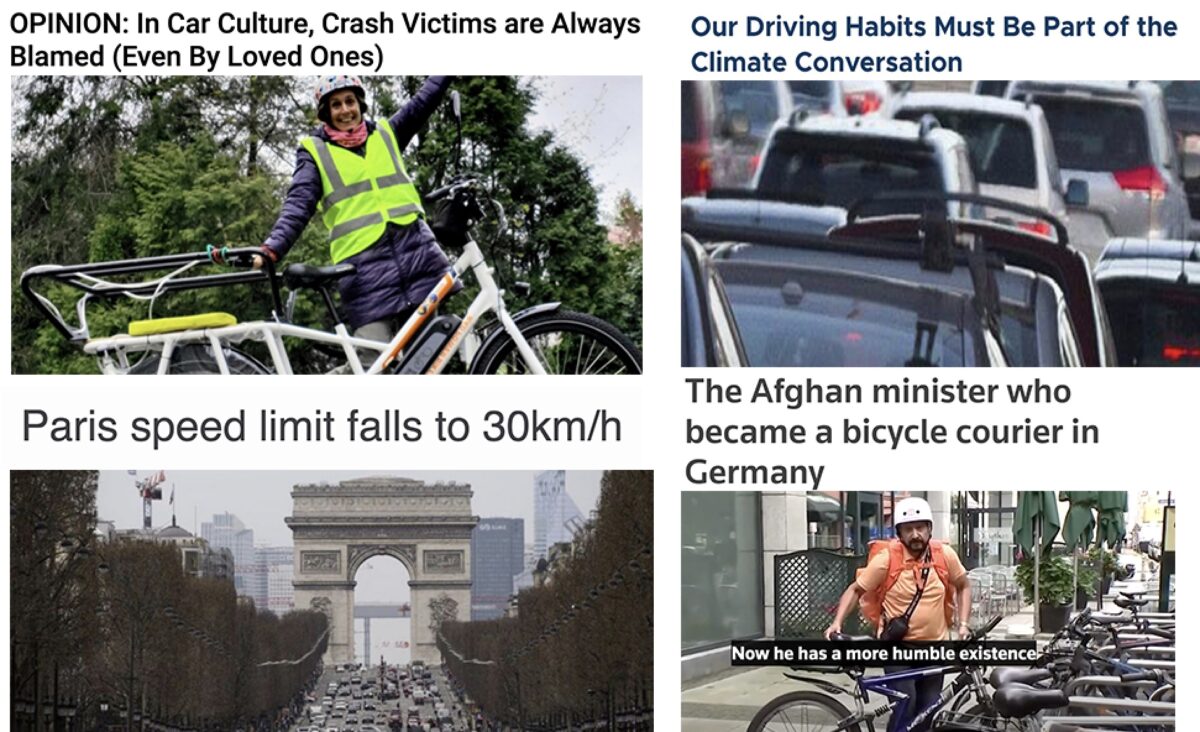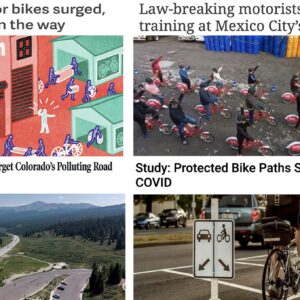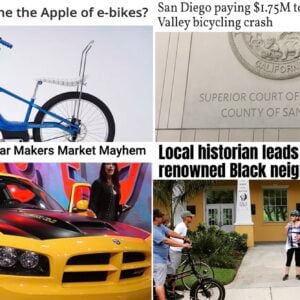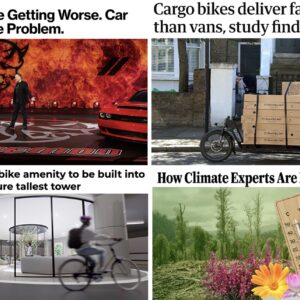Welcome to another wonderful Monday and the final days of August.
Here are the most notable items from reliable sources found by BikePortland editors and readers in the past seven days…
Great PR for ODOT: The Washington Post highlighted ten major infrastructure projects nationwide to show what’s a stake with looming federal funding and the I-5 Rose Quarter made the list.
From cabinet to courier: This amazing story from Reuters chronicles the evolution of a man who went from being a top-level minister in the Afghan government to being a food delivery bike courier in Germany.
Progress for congestion pricing: The MTA in New York City has gotten the green light from the Biden Administration to move forward with a plan that will charge people to drive into the core of Manhattan.
Victim blaming: A woman who bikes in suburban Connecticut shared an op-ed on Streetsblog about being hit by a car driver and how many of her friends treated her like she had it coming.
18 mph is plenty: The entire city of Paris is now under a new 30 kph speed limit as part of Mayor Anne Hidalgo’s continued effort to destroy the dominance of cars and improve the lives of all people.
Advertisement
We must drive less: One reason we are so squeamish about the tone from EV car boosters is that we cannot afford to sap urgency away from this inconvenient truth: We must drive less if we want any hope of beating back climate change.
Here’s how: It takes planning and a commitment to try new things, but if you can start by reducing a few trips a week you too could “escape car dependency”.
Spend wisely: The next fight for national bike advocates will be to steer billions in federal “highway” funding to smarter investments and a new report shows the very positive impact those funds could have if we spent them on projects that boost bicycle use.
That smell will cost you: The AAA is out with a new warning for people who love that new car smell: The annual cost of ownership for a new car tops $10,000 due to depreciation and maintenance costs.
Bucket list: National nonprofit Rails to Trails Conservancy says these are the top 10 trails in Oregon. How many have you ridden?
Touching tribute: A 53-year-old Scappoose resident is on a mission to ride her bike in all 50 states to raise awareness of ALS, a disease that took her husband’s life earlier this year.
New take on “peak car”: In a new book from Deputy Editor of The Economist Tom Standage, he argues that the best days of the almighty automobile are in the rear-view mirror.
— Jonathan Maus: (503) 706-8804, @jonathan_maus on Twitter and jonathan@bikeportland.org
— Get our headlines delivered to your inbox.
— Support this independent community media outlet with a one-time contribution or monthly subscription.








Thanks for reading.
BikePortland has served this community with independent community journalism since 2005. We rely on subscriptions from readers like you to survive. Your financial support is vital in keeping this valuable resource alive and well.
Please subscribe today to strengthen and expand our work.
RE: Victim Blaming: this is an outrage. The brains at work in America are running on ancient code. If they were computers, they would be updated or recycled. The mentality is a security risk. Time for change.
Great PR for ODOT: I love how the Washington Post peps up all these projects without giving any of the many good reasons they should be cancelled or why there’s local opposition. The Asheville airport is so close to Charlotte that it really should be closed, but since it caters to rich folks, it stays open. The I-70 highway is already one of the most expensive ever built and cuts right through some of the most scenic land in the USA – now it will get expanded and warm our planet even further. The port across from Savanna doesn’t need expanding near as much as it needs protection from rising oceans. And so on.
These projects need federal earmarks (pork barrel) precisely because they consistently failed NEPA reviews and easy criteria for state funding – they are all consistently bad projects for all kinds of really good reasons.
yeah it’s really sad how they were completely uncritical of the project even though it has been stymied by broad opposition at every turn, is the subject of lawsuits and is far from a sure thing.
One of the biggest beneficiaries of road projects like these is Amazon and Jeff Bezos.
Bezos owns the Washington Post.
Journalism – beyond token exceptions here and there – cannot challenge the power that owns it.
When Bill Gates walks into a bar, on average, everyone is a billionaire.
Average cost is a meaningless statistic. What matters is my cost of ownership, and that’s something I have a huge amount of control over. Anyone paying $10K a year to own a car is doing so voluntarily.
40% of the cost is depreciation according to AAA. Like a $1,000 bike being worth only $600 after it’s just been sold, $360 on the second year, $216 in the 3rd year, and near worthless after the chop shop guy down the street gets it. Minus repairs, upkeep, that useless Ottolock, the stretched chain, coffee stains, etc.
Sure, but the average tells me nothing about what owning a car will mean for me, because I’m going to pay cash for one that’s efficient, cheap, reliable, and decidedly unsexy (to most people, at least), while the average is driven upwards by Tesla and Lexus owners. How much to spend is up to me.
In the same way, I don’t consider “average household income” when setting my personal budget, or “average food cost” when deciding how much to spend on dinner tonight (which, in case you’re wondering, will be about $5).
Right. But what the AAA article says is that the average price for a recently-sold car is $32,903, so a 40% depreciation would equal $13,161 just for that hypothetical car just in the first year, $7,897 in the second year, and so on. New cars average $40,000 with a $16,000 first-year depreciation. So even with modest repairs, it’s easy to see where the $10,000 figure comes from. Obviously you are better off buying used, but as with good used bikes, good used cars are now at a premium. And most of us never factor in depreciation until we try to sell something ourselves and discover just how utterly worthless our crap really is.
So what does that average number tell me that is meaningful? It doesn’t tell me what I am paying, what I should expect to pay, or provide any helpful bounds around those figures. It doesn’t tell me what it costs to drive to the grocery store instead of biking. Even at a policy level it doesn’t tell me what the real-life costs of car ownership are for people I might want to help might be, or how that impacts their lives.
It’s a worthless number.
That is outlier data and it’s usually ignored.
RE Victim blaming: We often blame people who get in trouble doing dangerous or risky things, even if they are utterly innocent in the moment, and even if the danger is presented by other people (e.g. “You were beaten when you went to the chop-shop alone to retrieve your bike? What did you think would happen?”)
I don’t know whether bike riding in traffic should be considered risky or not, but many people see it that way. As long as they do, cyclist blaming will persist, no matter how much we tut-tut. It probably doesn’t help that it is all too common to see bikers riding in a way that is overtly dangerous, adding to the perception that riders are often at least partly responsible for their fate.
I feel the same way about people who live near and drive on high-speed, undivided rural roads, especially at night. Not sure why they are so lax with their lives and the lives of their loved ones.
https://www.npr.org/2009/11/29/120716625/the-deadliest-roads-are-rural
It’s only risky because of the motorized vehicles. So, this raises the question, “are motorists careless by nature?” Because it’s not the vehicle doing the driving, yet.
I was riding N on Barbur Blvd during the evening rush hour one day when a semi passed me. Normally this is a frightful experience because the curves encourage poor lane control. Especially for long vehicles like a semi truck. However, this particular driver passed me in such a careful way! I knew that they knew I was there and they were taking care not to hit me. It was really quite something to experience.
Then there’s other times when vehicles blast past me, too close for comfort. It’s unnecessary and careless.
I attribute this sort of observation as being driven by bias. Anyone who says, “cyclists are always riding dangerously” I would encourage them to look for safe cyclist behavior.
Incidentally, any cyclist who says, “all motorists are driving carelessly” I would encourage to look for those motorists who are looking out for you.
It’s bias informed observations.
Perhaps (or perhaps not), but that in no way invalidates my point.
Activities that carry 1 micro-mort of risk:
Motorcycle 6 miles
Walking 17 miles
Biking 20 miles
Driving 230 miles
Living in New York City or Boston for 2 days (air pollution)
“RMI analysisindicates that the United States must reduce VMT by 20 percent before the end of the decade to limit warming to 1.5°C”
First of all, RMI has a credibility problem given that it’s a think tank funded by two billionaires — Tom Steyer (carbon profiteer) and Richard Branson (airline owner). Secondly, the claims made in this piece are based on internal think tank reports that are not freely available (very poor form even for a billionaire-funded think tank). However, even without reading these reports it’s clear that this think tank is intentionally or blissfully ignorant of the substance of the UN IPCC consensus. As I have quoted and linked to previously on this site, the IPCC AR5 emphasizes electrification (e.g. EVs) and does not explicitly require a 20% reduction in VMT. Even worse, the authors seem to be unaware that overshoot above 1.5 C is part of every Shared Socioeconomic Pathway (SSP) in the IPCC AR6. Anyone who claims that we can limit warming to 1.5 C is either ignorant of the climate science consensus or has undisclosed interests that require dishonesty.
There are many strong arguments (it’s cheaper, healthier, faster, less extractive, and more equitable) for reducing VMT and increasing use of mass transit and human-powered transportation but willfully misrepresenting the climate science consensus undermines those arguments, ATMO.